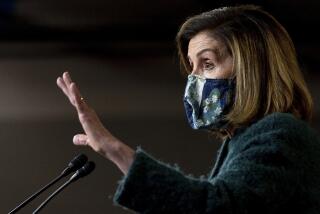NEWS ANALYSIS : Hosokawa Plan Lifts Growth Hopes From Zero : Japan: Program could benefit businesses, farms and banks. Analysts see it as a bare necessity.
- Share via
TOKYO — Prime Minister Morihiro Hosokawa won some political breathing space Tuesday, when his fractious ruling coalition agreed on a $140-billion economic stimulus package.
But doubts remain over how much the program will help the Japanese economy--and that means it may also be of limited value to Hosokawa when he meets with President Clinton in Washington on Friday.
The United States has pressed Japan to take strong measures to boost domestic demand, which should draw in imports and help reduce Japan’s huge trade surplus with the United States, estimated at about $55 billion last year. Pressure to correct the imbalance was further intensified with the news Monday that Japan’s current-account surplus had widened to a record $131.35 billion in 1993 from $117.55 billion the previous year.
U.S. Treasury Secretary Lloyd Bentsen said Tuesday that Japan’s economic stimulus plan may not be enough to spark any substantial increase in Japanese demand for U.S. goods.
“This is a modest step,” he said. “Every little bit helps . . . (but) it remains to be seen whether this package will be adequate to spur strong domestic demand and to reduce the (trade imbalance) significantly.”
Japanese government and private-sector predictions as to how much the stimulating measures will boost Japan’s economy this year range from about 0.6% to 2.2%. Growth predictions hover near zero without such a package, so that means many observers expect the government effort to account for most of Japan’s growth this year--and that, even with the measures, growth could be very anemic.
*
“The economy is already showing some symptoms of picking up by itself,” said a Ministry of Finance official who briefed reporters on condition of anonymity. “Boosted by this package, I’m pretty sure the Japanese economy will recover.”
Geoffrey Barker, an analyst with Baring Securities Ltd., agreed that the package should aid a modest recovery already starting to unfold. “January car sales were particularly encouraging,” he said. “This package is adding fuel to the fire.”
Others reacted with less confidence. “The economy is flabby. (Government action) is not going to have the kind of impact that people are looking for,” said Paul Summerville, an economist at Lehman Brothers.
One problem is that the plan’s income tax cuts--worth $49 billion and retroactive to Jan. 1--are a sure thing only for this year.
The ruling parties agreed to try to decide by the end of the year on some kind of balancing tax increase. The presumption is that if agreement is reached on increasing some other tax, the lower income tax rates will be extended indefinitely. But the specter of a future tax increase may chill consumers’ willingness to spend the extra money they get now.
*
The government’s stimulus measures are to be financed by deficit bonds, over what had been strong objections from the Finance Ministry.
The package has three broad parts addressing various aspects of Japan’s economic ills.
The biggest portion--worth about $120 billion--consists of tax cuts and spending programs.
Another $20 billion is allocated to various programs whose main purpose is to address structural problems. These include funds to ease land transactions between private parties, measures to help small businesses adjust to changing conditions, employer subsidies to fight growing unemployment, aid to farmers adjusting to liberalization of food imports and help for banks burdened with too many bad loans.
The third part of the package consists of policy measures, such as steps toward deregulating the economy and further opening Japanese markets to foreign goods and services.
On the Tokyo stock exchange, news of the government’s stimulus plan helped push the Nikkei index up 237 points, or 1.2%, to 20,251 at the close of trading Tuesday.
More to Read
Sign up for Essential California
The most important California stories and recommendations in your inbox every morning.
You may occasionally receive promotional content from the Los Angeles Times.













